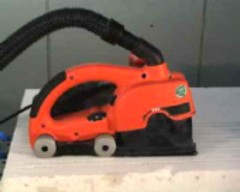- Missions of the IFA
- Fields of activity
- Organisation
- How to find us - Address - E-Mail
- Impressum
Emission of Hazardous Substances

Determining the quartz dust emissions of a bricklayer's groove milling cutter on the test bench for machines emitting hazardous substances, Source: IFA
In its capacity as a test and certification body, the IFA is associated with DGUV Test, the testing and certification system of the German Social Accident Insurance. Machinery and equipment is tested for emissions of hazardous substances in the section "Emission of Hazardous Substances of the deaprtment Hazardous Substances: Handling - Protective Measures. Principle studies are also conducted into hazardous substance emissions from machinery or working processes.
Testing of hazardous substance emissions from machines
Machinery and equipment is tested with regard to its hazardous substance emissions on behalf of manufacturers or distributors in the process of type testing. The tests are generally based upon standards or test principles defining product-specific safety requirements. They may take the form of sub-tests for specific hazardous substances, or comprehensive safety tests conducted in conjunction with other units.
Where a product satisfies the requirements, the customer is issued with a test certificate entitling him to label it, for example with the DGUV test mark or, where comprehensive safety tests have been performed, with the GS mark. Machines that have passed the tests are listed in the DGUV Test database and on lists of approved products in the IFA-HANDBUCHdigital, the IFA's digital manual.
Tests are available for:
- Welding fume separation equipment
- Devices for capturing of welding fumes
- Filter units and separation equipment for wood dust and chip (tests of specific dust properties are commissioned by the German Social Accident Insurance Institution for the woodworking and metalworking industries, Stuttgart)
- Equipment for capturing and separation of dust used in dental laboratories
- Office equipment used for printing, such as laser printers and photocopiers
Principle studies
Principle studies are generally conducted in conjunction with the responsible individual social accident insurance institutions. The purpose of the studies is usually to develop safety requirements and test methods for individual items of machinery or equipment, and to describe these requirements and methods in national or international standards in order to enable the hazardous substance emissions from the machinery and equipment concerned to be tested against the standards in question. Such studies have for example been performed in the past on woodworking machines, wall chasers and office equipment.